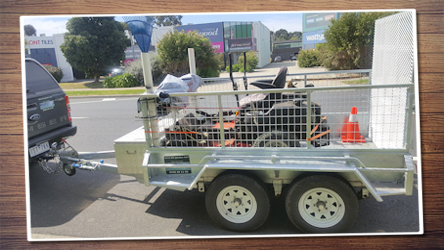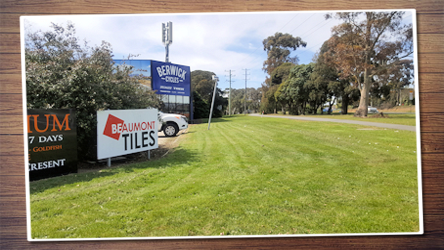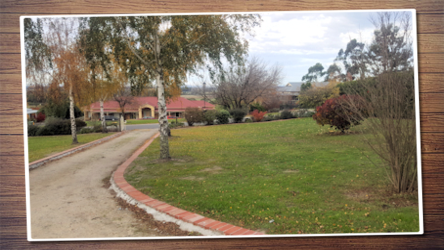
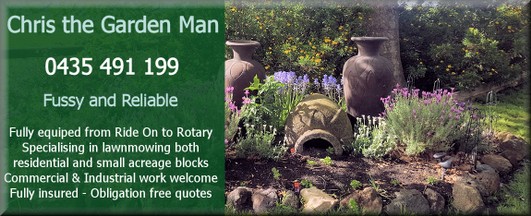
Chris the Garden Man is located in Nar Nar Goon and specialises in lawnmowing both residential and small acreage blocks, Chris also does commercial and industrial work.
Chris owns a Toro self-propelled mower for residential use; and a 48-inch zero turn Ride On for small acreage work. Chris will also do the edges and use a blower to clean paths etc.
There's not a great deal more we can tell you about the mowing service Chris provides so we have added a special feature created by Chris.....

Handy Garden Tips by Chris

The Art Of Mowing Your Lawn
Believe us, lawn envy is real! Have you ever seen a lawn so perfectly cut and pristine? They might make it look easy, but there are a lot of factors that come into play when it comes to perfecting your lawn. If you’re growing new lawn or figuring out the best way to regrow your grass, you know it can be a guessing game when it comes to the weather, how much sun or shade it gets, water quality and your soil type.
While it might seem like the battle is lost, there are ways you can become the master of your grass, and it all starts with your lawn mowing strategy. Have you thought about when the best time to mow your lawn is? Sometimes life gets in the way and we end up mowing grass wet or when it’s convenient, but there are the best times of day to mow lawn for optimal results.
The Best Time To Mow Your Lawn
Think about the time of year and climate you’re living in; if it’s during the warmer months with fast growing grass and you aren’t able to mow your lawn every week or two, why not find a lawn mowing service to do the hard work? Once the weather cools down, you’ll be able to do it yourself every two to five weeks.
Climate is one thing, but figuring out the best time of day to mow the lawn is another. When your grass is dry and the morning dew has evaporated, around 10am, it’s the optimal time to cut your grass. Alternatively, late afternoon works as you beat the heat of the day and get in before nightfall. Avoid mowing your lawn when it’s been raining as the blades will tear the grass, instead of providing a clean cut, don’t let your hard work go to waste!
How To Look After Your Lawn
Keeping a neat and tidy grass area adds the finishing touch to any garden, and by knowing the best height for your grass you can make it look professionally done. Ask your supplier, but most grass should be between four to seven centimetres high, avoid cutting more than one third of the grass length; this allows ventilation and sun to the grassroots, reducing weed growth and fewer pest problems.
A light mow means you can leave grass clippings as mulch, but raking them to evenly spread and avoid dead patches due to smothering. If your grass has become long and out of hand, the best plan of action is to lightly and frequently cut the lawn, rather than taking on the whole lot in one go.
Keep your lawn looking healthy year round by fertilising early in the growing season with a good quality product that can be delivered by hand or dispenser, and fertilise every six weeks. A ‘weed and feed’ product is good if you have pesky weeds that won’t go away; you can also add seed to the mix for any dead patches or holes that are bothering you.
The Right Tools For Mowing Your Lawn
Mowing the lawn yourself? You need a good lawn mower for the job, otherwise you’ll be doing twice as much work on one area! Find a mower to suit your lawn size and situation, larger lawns need a decent mower or ride on, selecting a grass mower like the Toro 22" Personal Pace Recycler Lawn Mower I use; is easy maintenance with lightweight agility.
If your lawn area is smaller, electric and battery options are available, with less noise impact on your neighbours. Look after your mower by keeping it in a clean, dry place with blades in good condition. If it needs a bit of maintenance work, take it past your local repair shop for a service, you don’t want to be going over the same patch all day! You’ll soon be the one with a pristine lawn that’ll turn your neighbours green with envy.

Weeds
You can control summer weeds as well as winter weeds with a pre-emergent herbicide such as Oxafert. The beauty of Oxafert is it stops weeds appearing, plus it contains a fertiliser component as well to give your lawn a lift.
Applied correctly, the pre-emergent herbicide component will kill stubborn annual weeds before they appear, whilst the fertiliser component will provide the necessary nutrients to keep your lawn looking greener and healthier all year-round.
The idea of using a pre-emergent herbicide is to target weed seeds before they take hold by forming a barrier at soil level that affects the germination of any new seedlings. The combination of fertiliser and pre-emergent product provides an ideal mechanism to take the herbicide to just under the soil and the fertiliser helps give a quick boost to your lawn. Controlling both broadleaf and annual grass-type weeds including Winter Grass, Crowsfoot, Summer Grass, Creeping Oxalis and Crabgrass, the pre-emergent herbicide works by stopping any new seedings in their tracks – yet won’t inhibit any root growth of your established turf. The herbicide active ingredient has a residual effect for around three months, so is ideal to apply seasonally to coincide with the different weed types throughout the year.
WARNING - Toxic poisoning
If any of you have dogs and have Yucca tree’s , please remove the yuccas from your property or ensure your canine or pet can not get near them.
Yuccas are not only toxic but poisonous to canines.
Yuccas create toxic poisonous shock, that creates an infection. This is deadly and can result in losing your canine, should this not treated or attended to straight away.
Many sites will only tell you about the affects of a canine eating the plant and how toxic it is to canines, cats and horses. Humans can have a allergic reaction to the plant.
The articles do not tell you how toxic and how quick the poisoning travels through blood stream when being cut or deeply pricked by one.
First signs of poisoning is - vomiting , the runs (loose stool), dehydration and lethargic followed by high temps. - Weakness, Drooling , Muscle tremors and seizures.
Here is some of the list of plants that are also toxic to canines -
Agapanthus (Roots)
Aloe (Leaves)
Angels Trumpet (All parts)
Apricots (Stem, bark and seed kernels)
Arum Lily (Spine and bulbs)
Asparagus Fern (All parts)
Avocado (Fruit, leaves, bark, seed)
Azalea (All parts)
Bird of Paradise (Fruit, seeds)
Caladium (All parts)
Cape Lilac (Berries)
Clematis (All parts)
Cotoneaster glaucophyllus (Fruit)
Cycads (Seeds)
Daffodils (All parts but especially bulbs)
Daphne (Berries, bark, leaves)
Dumb Cane Dieffenbachia (All parts)
Foxgloves (Leaves, seeds, flowers)
Frangipani (Sap)
Gladioli (Bulbs)
Hellebore (All parts)
Hyacinth (Bulbs, leaves, flowers)
Hydrangea (Leaves, stems)
Ivy (All parts of most varieties)
Jonquil (Bulbs)
Kalanchoe (All parts)
Lantana (All parts)
Lily (All parts)
Lily of the Valley (All parts)
Lobelia (All parts)
Macadamia (Nuts)
Fruit Salad Plant Monstera (Unripe fruit)
Morning Glory (Seeds)
Nightshade (All parts)
Oleander (All parts, including dead leaves)
Onion (Bulbs)
Ornamental chilli (Fruit)
Philodendron (All parts)
Poinsettia (Leaves, flowers)
Rhododendron (All parts)
Rhubarb (Leaves)
Savin Juniper (All parts)
Sweet Pea (Seeds, pods)
Tomato Plants (Leaves)
Tulip (Bulbs)
Umbrella Plant (All parts)
Wandering Jew (Leaves, stems, sap)
Wisteria (Seeds, pods)
Yesterday, Today, Tomorrow (All parts)
also known as Brunfelsia pauciflora
Yucca (All parts)
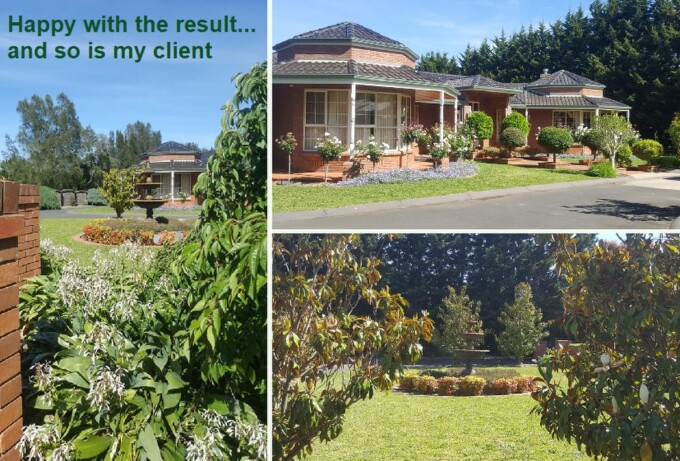

Fully Insured and obligation free quotes.
Chris focuses on Ride on Mower work.
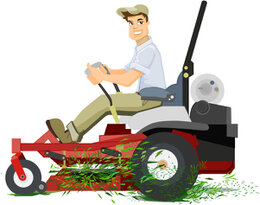
0435 491 199
